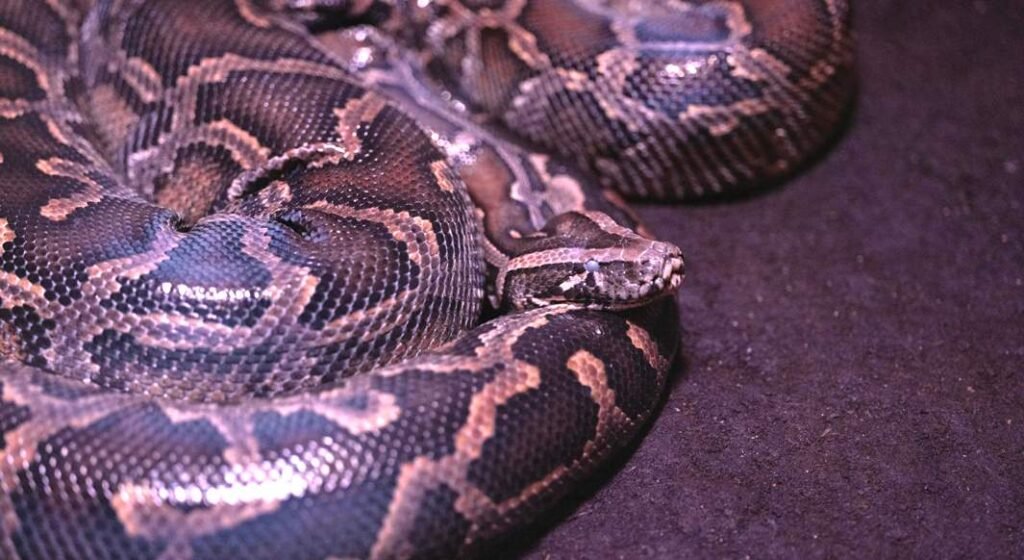The Indian Rock Python (Python molurus) is one of the most awe-inspiring reptiles found in the Indian subcontinent. Known for its massive size, gentle demeanor, and critical role in the ecosystem, this non-venomous constrictor is both feared and revered. Despite its intimidating appearance, it poses no venomous threat to humans and plays a vital part in maintaining ecological balance.(Facebook)
Indian Rock Python : Non-Venomous Snake
Indian Rock Python: Species Profile
| Attribute | Details |
|---|---|
| Common Names | Indian Rock Python, Black-tailed Python, Asian Rock Python |
| Scientific Name | Python molurus |
| Wildlife Protection Act | Schedule I – Highest protection under the Indian Wildlife (Protection) Act, 1972 |
| Regional Names | Hindi: अज़गर, Marathi: भारतीय अजगर, चित्री (Vidarbha), मासुल (Gadchiroli) Gujarati: અજગર Kannada: ಹೆಬ್ಬಾವು Malayalam: പെരുമ്പാമ്പ് Tamil: இந்திய மலைப் பாம்பு |
| Physical Description | Large, heavy-bodied snake with a whitish or yellowish base color and blotched patterns varying from tan to dark brown. Coloration varies with habitat; darker in hill forests, lighter in drier regions . |
| Habitat | Grasslands, swamps, marshes, rocky foothills, woodlands, open forests, and river valleys . |
| Diet | Carnivorous; feeds on mammals, birds, reptiles, and amphibians. Utilizes constriction to subdue prey . |
| Behavior | Nocturnal but can be seen basking during the day. Solitary and ambush predator. Known for its docile nature . |
| Venomous | No; non-venomous constrictor. |
| Venom Type | Not applicable. |
| Venom Effects on Prey | Not applicable; kills prey through constriction. |
| Venom Effects on Humans | Not applicable; poses no venomous threat to humans. |
| Common or Rare | Common in suitable habitats but facing threats from habitat destruction and illegal trade . |
| Life Span | Up to 30 years in the wild . |
| Mating & Reproduction | Breeding occurs from November to January. Females lay 20–100 eggs, which hatch after 60–80 days. Females exhibit maternal care by incubating the eggs . |

Introduction to Indian Rock Pythons
The Indian Rock Python is a non-venomous snake species native to the Indian subcontinent. It is one of the largest snake species in the region, with some individuals reaching lengths of up to 20 feet. Despite its size, it is known for its docile nature and poses no venomous threat to humans. The python’s coloration varies depending on its habitat, ranging from whitish or yellowish with blotched patterns to darker shades in forested regions .(SnakeEstate, Earths Endangered, Vajiram & Ravi)
Anatomically, the Indian Rock Python is equipped with strong muscles that aid in constricting its prey. It has heat-sensing pits along its jaws, allowing it to detect warm-blooded prey even in the dark. Its jaws are highly flexible, enabling it to consume prey much larger than its head. The python’s slow metabolism allows it to survive on infrequent meals, sometimes going weeks or months between feedings.
In the ecosystem, the Indian Rock Python plays a crucial role in controlling the populations of various prey species, including rodents and other small mammals. By maintaining this balance, it helps prevent overgrazing and the spread of diseases. Despite its ecological importance, the python faces threats from habitat destruction, poaching, and human-wildlife conflict. Conservation efforts are essential to ensure the survival of this remarkable species.
Habitat and Distribution
Indian Rock Pythons inhabit a variety of ecosystems across the Indian subcontinent. They are commonly found in grasslands, swamps, marshes, rocky foothills, woodlands, open forests, and river valleys . These habitats provide the necessary cover and prey availability for the python to thrive.(Facebook, World for Nature)
Geographically, the Indian Rock Python is distributed throughout India, Nepal, Bhutan, Bangladesh, and parts of Pakistan and Sri Lanka . In India, they are prevalent in the Western Ghats, Eastern Ghats, the Himalayan foothills, and the northeastern states. Their presence in diverse habitats showcases their adaptability to different environmental conditions.
However, habitat destruction due to deforestation, agricultural expansion, and urbanization poses significant threats to their populations. Conservation areas and protected reserves play a vital role in providing safe habitats for these snakes. Efforts to preserve and restore natural habitats are crucial for the continued survival of the Indian Rock Python.
| Habitat Type | Characteristics | Regions Found |
|---|---|---|
| Grasslands | Open areas with tall grasses | Central and Western India |
| Swamps & Marshes | Wetlands with abundant water | Eastern India, Sundarbans |
| Rocky Foothills | Hilly terrains with rocks | Western Ghats, Eastern Ghats |
| Woodlands & Forests | Dense tree cover | Northeastern states, Himalayan foothills |
| River Valleys | Areas adjacent to rivers | Throughout the subcontinent |
Snake Behavior
Hunting and Feeding Habits: The Indian Rock Python is an ambush predator, relying on stealth and patience to capture its prey. It uses its heat-sensing pits to detect warm-blooded animals, striking swiftly and constricting them until suffocation. Its diet includes mammals, birds, reptiles, and amphibians . After consuming a large meal, the python may remain inactive for extended periods, digesting its food.(World for Nature)
Mating and Reproduction: Breeding occurs during the cooler months, from November to January. Females lay between 20 to 100 eggs, depending on their size and health. The female coils around the eggs, providing warmth and protection until they hatch after 60 to 80 days . This maternal care is relatively rare among snakes and highlights the python’s unique reproductive behavior.(HowStuffWorks, Creatures of the World)
Defense Mechanisms: While non-venomous, the Indian Rock Python employs several defense strategies. Its cryptic coloration allows it to blend into its surroundings, avoiding detection. When threatened, it may hiss loudly and inflate its body to appear larger. If provoked further, it can deliver a powerful bite and constrict the threat. However, it generally prefers to retreat rather than confront.
First Aid and Medical Treatment for Indian Rock Python Bites
Although Indian Rock Pythons are non-venomous, a bite can cause puncture wounds, bruising, and potential infection. Immediate first aid involves cleaning the wound thoroughly with antiseptic and applying a sterile bandage. It’s essential to monitor for signs of infection, such as redness, swelling, or pus. Seeking medical attention is advisable to assess the injury and receive appropriate care. Tetanus prophylaxis may be recommended, especially if the individual’s vaccination status is uncertain.
Global Impact of Indian Rock Python
The Indian Rock Python (Python molurus) is native to the Indian subcontinent, but its significance reaches beyond regional borders. As one of the largest non-venomous snakes in the world, it has garnered global interest among herpetologists, wildlife researchers, conservationists, and reptile enthusiasts alike.
In the global context, this species is often studied for its unique method of constriction, maternal behavior, and adaptive survival strategies in diverse ecosystems. It serves as an important representative of Old World pythons and is frequently featured in documentaries and educational materials about reptiles and their ecological importance.
Additionally, the Indian Rock Python is sometimes confused with its close cousin, the Burmese Python (Python bivittatus), which is native to Southeast Asia but has become an invasive species in the Florida Everglades. This has raised awareness about the importance of monitoring exotic pet trade and the responsible treatment of native species like Python molurus.
Threats and Conservation Status
Despite its ecological significance, the Indian Rock Python faces numerous threats in the wild:
- Habitat Loss: Due to rapid urbanization, deforestation, and agricultural expansion, the natural habitats of these snakes are shrinking.
- Poaching & Illegal Trade: Pythons are hunted for their beautiful skin, used in leather goods, and for the illegal pet trade.
- Human-Wildlife Conflict: As human settlements expand into forest areas, pythons often come into conflict with people, leading to persecution out of fear.
The Indian Wildlife (Protection) Act, 1972, lists the Indian Rock Python under Schedule I, granting it the highest level of legal protection in India. Capturing, harming, or trading this species is a criminal offense.
Globally, it is listed as “Near Threatened” on the IUCN Red List, which means it is at risk of becoming endangered if current threats continue (IUCN link).
Role in the Ecosystem
The Indian Rock Python plays a vital role in maintaining ecological balance:
- It helps control rodent populations, preventing crop damage and the spread of diseases.
- It also preys on various small mammals, birds, and reptiles, keeping prey populations in check.
- Being a top predator in its environment, its presence is a sign of a healthy ecosystem.
Its decline could disturb the food chain and lead to an overpopulation of certain species, which would eventually harm the habitat.
Fun and Fascinating Facts about the Indian Rock Python
Here are some cool facts that make the Indian Rock Python even more amazing:
🔹 They can go months without eating after a big meal, thanks to their slow metabolism.
🔹 They have no fangs or venom, yet they are capable of taking down prey as big as a deer or monkey through constriction.
🔹 They can hold their breath for several minutes, allowing them to ambush prey near water bodies.
🔹 They can climb trees and swim well, making them one of the most versatile snakes in India.
🔹 Mothers incubate their eggs by shivering—a rare form of maternal care in reptiles!
How to Identify an Indian Rock Python
If you’re out in the wild and think you’ve spotted a Python, here are a few ways to identify an Indian Rock Python:
| Identification Trait | Details |
|---|---|
| Size | Can grow over 10 feet; very thick-bodied |
| Color | Light base color with brown or tan blotches |
| Tail | Dark, almost black tail (hence “black-tailed python”) |
| Head Shape | Distinct arrow-shaped marking on the head |
| Behavior | Calm, slow-moving, rarely aggressive |
Important Note: Never approach or provoke a wild snake, even if it seems non-venomous. Always admire from a safe distance or inform forest officials if you spot one in a human-populated area.
Message from Wildlife Nest
At WildlifeNest.com, we believe in spreading awareness about India’s incredible wildlife and the importance of living in harmony with nature. The Indian Rock Python is not a threat but a natural treasure that deserves our respect and protection.
Whether you’re a wildlife lover, student, or curious adventurer—learning about snakes like the Indian Rock Python can change fear into fascination. Keep exploring, stay informed, and help us protect these majestic creatures!
Frequently Asked Questions (FAQs) – Indian Rock Python
1. Is the Indian Rock Python venomous?
No, the Indian Rock Python is non-venomous. It kills its prey using constriction, meaning it wraps around the animal and squeezes until the prey cannot breathe.
2. How does the Indian Rock Python kill its prey?
Instead of using venom, the python uses its powerful muscles to constrict its prey. This method is quick and effective. Once the prey stops breathing, the python swallows it whole, usually headfirst.
3. Where can the Indian Rock Python be found?
The Indian Rock Python is mainly found in India, Nepal, Bangladesh, Pakistan, and Sri Lanka. It lives in a variety of habitats including forests, wetlands, grasslands, rocky hills, and even near farmlands.
4. Is the Indian Rock Python dangerous to humans?
Not really. The Indian Rock Python is a shy and calm species. It usually avoids humans and only reacts if threatened or cornered. There have been very few instances of any aggressive behavior unless it’s provoked.
5. Does it have any legal protection in India?
Yes! The Indian Rock Python is protected under the Indian Wildlife Protection Act, 1972 (Schedule I). This means it is illegal to capture, harm, or trade this snake. It is given the highest level of protection in the country.
6. What is the average size of an Indian Rock Python?
Most Indian Rock Pythons grow to be around 10 to 12 feet long, but some have been recorded at over 15 feet! Despite their size, they are slow-moving and non-aggressive.
7. What do Indian Rock Pythons eat?
Their diet includes rodents, birds, reptiles, small deer, monkeys, and other mammals. They are ambush predators, meaning they lie in wait for the right moment to strike.
8. Can the Indian Rock Python swim or climb trees?
Yes! They are excellent swimmers and can also climb trees when necessary. This helps them hunt and also find safe places for resting or laying eggs.
9. How do they reproduce?
Female Indian Rock Pythons lay 20–100 eggs in burrows or hidden places. Interestingly, the mother guards and incubates the eggs by coiling around them and shivering to generate heat. This is rare behavior among reptiles!
10. What should I do if I see an Indian Rock Python?
First, stay calm and keep a safe distance. Don’t try to touch or chase it. Inform local forest officials or wildlife rescue teams. These snakes are important for nature and deserve our respect and protection.
Related Information
| Topic | Link |
|---|---|
| History of Snakes: Evolution, Habitats, and Survival | Click here |
| The Big Four Snakes of India | Click here |
| What Are Reptiles? | Click here |
| Cobra Snake: All Information | Click here |
| Russell’s Viper | Click here |
| Common Krait: All Information | Click here |
| Saw-Scaled Viper: All Information | Click here |
| King Cobra: All Information | Click here |
| Watch Snake Videos on YouTube | Click here |


